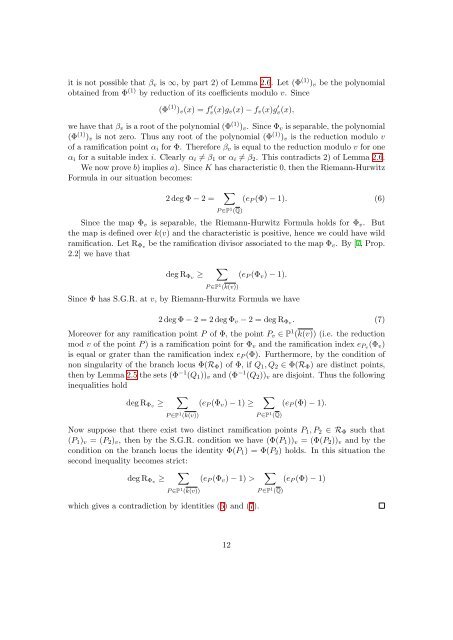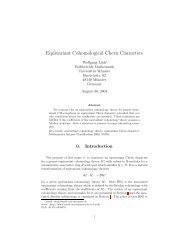On some notions of good reduction for endomorphisms of the ...
On some notions of good reduction for endomorphisms of the ...
On some notions of good reduction for endomorphisms of the ...
Create successful ePaper yourself
Turn your PDF publications into a flip-book with our unique Google optimized e-Paper software.
it is not possible that β v is ∞, by part 2) <strong>of</strong> Lemma 2.6. Let (Φ (1) ) v be <strong>the</strong> polynomial<br />
obtained from Φ (1) by <strong>reduction</strong> <strong>of</strong> its coefficients modulo v. Since<br />
(Φ (1) ) v (x) = f ′ v(x)g v (x) − f v (x)g ′ v(x),<br />
we have that β v is a root <strong>of</strong> <strong>the</strong> polynomial (Φ (1) ) v . Since Φ v is separable, <strong>the</strong> polynomial<br />
(Φ (1) ) v is not zero. Thus any root <strong>of</strong> <strong>the</strong> polynomial (Φ (1) ) v is <strong>the</strong> <strong>reduction</strong> modulo v<br />
<strong>of</strong> a ramification point α i <strong>for</strong> Φ. There<strong>for</strong>e β v is equal to <strong>the</strong> <strong>reduction</strong> modulo v <strong>for</strong> one<br />
α i <strong>for</strong> a suitable index i. Clearly α i ≠ β 1 or α i ≠ β 2 . This contradicts 2) <strong>of</strong> Lemma 2.6.<br />
We now prove b) implies a). Since K has characteristic 0, <strong>the</strong>n <strong>the</strong> Riemann-Hurwitz<br />
Formula in our situation becomes:<br />
2 deg Φ − 2 = ∑<br />
P ∈P 1 (Q)<br />
(e P (Φ) − 1). (6)<br />
Since <strong>the</strong> map Φ v is separable, <strong>the</strong> Riemann-Hurwitz Formula holds <strong>for</strong> Φ v . But<br />
<strong>the</strong> map is defined over k(v) and <strong>the</strong> characteristic is positive, hence we could have wild<br />
ramification. Let R Φv be <strong>the</strong> ramification divisor associated to <strong>the</strong> map Φ v . By [7, Prop.<br />
2.2] we have that<br />
deg R Φv ≥<br />
∑<br />
P ∈P 1 (k(v))<br />
(e P (Φ v ) − 1).<br />
Since Φ has S.G.R. at v, by Riemann-Hurwitz Formula we have<br />
2 deg Φ − 2 = 2 deg Φ v − 2 = deg R Φv . (7)<br />
Moreover <strong>for</strong> any ramification point P <strong>of</strong> Φ, <strong>the</strong> point P v ∈ P 1 (k(v)) (i.e. <strong>the</strong> <strong>reduction</strong><br />
mod v <strong>of</strong> <strong>the</strong> point P ) is a ramification point <strong>for</strong> Φ v and <strong>the</strong> ramification index e Pv (Φ v )<br />
is equal or grater than <strong>the</strong> ramification index e P (Φ). Fur<strong>the</strong>rmore, by <strong>the</strong> condition <strong>of</strong><br />
non singularity <strong>of</strong> <strong>the</strong> branch locus Φ(R Φ ) <strong>of</strong> Φ, if Q 1 , Q 2 ∈ Φ(R Φ ) are distinct points,<br />
<strong>the</strong>n by Lemma 2.5 <strong>the</strong> sets (Φ −1 (Q 1 )) v and (Φ −1 (Q 2 )) v are disjoint. Thus <strong>the</strong> following<br />
inequalities hold<br />
deg R Φv ≥<br />
∑<br />
(e P (Φ v ) − 1) ≥ ∑<br />
(e P (Φ) − 1).<br />
P ∈P 1 (k(v))<br />
P ∈P 1 (Q)<br />
Now suppose that <strong>the</strong>re exist two distinct ramification points P 1 , P 2 ∈ R Φ such that<br />
(P 1 ) v = (P 2 ) v , <strong>the</strong>n by <strong>the</strong> S.G.R. condition we have (Φ(P 1 )) v = (Φ(P 2 )) v and by <strong>the</strong><br />
condition on <strong>the</strong> branch locus <strong>the</strong> identity Φ(P 1 ) = Φ(P 2 ) holds. In this situation <strong>the</strong><br />
second inequality becomes strict:<br />
deg R Φv ≥<br />
∑<br />
(e P (Φ v ) − 1) > ∑<br />
(e P (Φ) − 1)<br />
P ∈P 1 (k(v))<br />
which gives a contradiction by identities (6) and (7).<br />
P ∈P 1 (Q)<br />
12

















